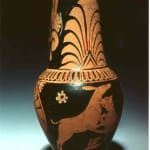Etruscan Red Figure Beaked Oinochoe, 400 BCE - 300 BCE
Terracotta
8.625
X.0064
Further images
Our knowledge about the Etruscan civilization is extremely limited. Our understanding of their language is still incomplete and most of the information that is known comes to us through the...
Our knowledge about the Etruscan civilization is extremely limited. Our understanding of their language is still incomplete and most of the information that is known comes to us through the Romans, their one-time subjects who grew to become their masters. The Etruscans lived under a series of autonomous city-states spread out across northern and central Italy. By the 3rd Century B.C., they would be absorbed into the burgeoning Roman Empire.
This red-figure beaked oinochoe bears a heavy resemblance to the terracotta wares created in the Greek colonies of Southern Italy, known in antiquity as Magna Graecia, revealing a link and cultural interchange between these two cultures. The ovoid body depicts a scene of a spotted feline (likely a leopard or a panther) attacking a long-eared stag. The painter has captured the most dramatic moment of the hunt, foregoing the chase for the moment of impact. Having just pounced at his prey, the large feline bites into the neck of the stag, his powerful jaw beginning to tear into the flesh. There are two small rosettes highlighted with white paints in the fields to the left and right of the animals, and a small plant growing out of the ground beneath the body of the stag, successfully situating this scene in a natural outdoor setting. Flanking the scene are large palmettes, a motif repeated on the neck of the vessel. These palmettes can also occurs in the decorative elements of Magna Graecian works. This beautiful vessel reveals the aesthetic dialogue that took place between the native Etruscans and their Greek neighbors to the south.
This red-figure beaked oinochoe bears a heavy resemblance to the terracotta wares created in the Greek colonies of Southern Italy, known in antiquity as Magna Graecia, revealing a link and cultural interchange between these two cultures. The ovoid body depicts a scene of a spotted feline (likely a leopard or a panther) attacking a long-eared stag. The painter has captured the most dramatic moment of the hunt, foregoing the chase for the moment of impact. Having just pounced at his prey, the large feline bites into the neck of the stag, his powerful jaw beginning to tear into the flesh. There are two small rosettes highlighted with white paints in the fields to the left and right of the animals, and a small plant growing out of the ground beneath the body of the stag, successfully situating this scene in a natural outdoor setting. Flanking the scene are large palmettes, a motif repeated on the neck of the vessel. These palmettes can also occurs in the decorative elements of Magna Graecian works. This beautiful vessel reveals the aesthetic dialogue that took place between the native Etruscans and their Greek neighbors to the south.





